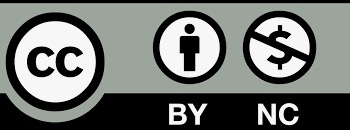Published
2025-02-06
Section
Research Articles
License
The journal adopts the Attribution-NonCommercial 4.0 International (CC BY-NC 4.0), which means that anyone can reuse and redistribute the materials for non-commercial purposes as long as you follow the license terms and the original source is properly cited.
Author(s) shall retain the copyright of their work and grant the Journal/Publisher rights for the first publication with the work concurrently licensed since 2023 Vol.8 No.2.
Under this license, author(s) will allow third parties to download, reuse, reprint, modify, distribute and/or copy the content under the condition that the authors are given credit. No permission is required from the authors or the publisher.
This broad license intends to facilitate free access, as well as the unrestricted use of original works of all types. This ensures that the published work is freely and openly available in perpetuity.
By providing open access, the following benefits are brought about:
- Higher Visibility, Availability and Citations-free and unlimited accessibility of the publication over the internet without any restrictions increases citation of the article.
- Ease of search-publications are easily searchable in search engines and indexing databases.
- Rapid Publication – accepted papers are immediately published online.
- Available for free download immediately after publication at https://esp.as-pub.com/index.php/ESP

Copyright Statement
1.The authors certify that the submitted manuscripts are original works, do not infringe the rights of others, are free from academic misconduct and confidentiality issues, and that there are no disputes over the authorship scheme of the collaborative articles. In case of infringement, academic misconduct and confidentiality issues, as well as disputes over the authorship scheme, all responsibilities will be borne by the authors.
2. The author agrees to grant the Editorial Office of Environment and Social Psychology a licence to use the reproduction right, distribution right, information network dissemination right, performance right, translation right, and compilation right of the submitted manuscript, including the work as a whole, as well as the diagrams, tables, abstracts, and any other parts that can be extracted from the work and used in accordance with the characteristics of the journal. The Editorial Board of Environment and Social Psychology has the right to use and sub-licence the above mentioned works for wide dissemination in print, electronic and online versions, and, in accordance with the characteristics of the periodical, for the period of legal protection of the property right of the copyright in the work, and for the territorial scope of the work throughout the world.
3. The authors are entitled to the copyright of their works under the relevant laws of Singapore, provided that they do not exercise their rights in a manner prejudicial to the interests of the Journal.
About Licence
Environment and Social Psychology is an open access journal and all published work is available under the Creative Commons Licence, Authors shall retain copyright of their work and grant the journal/publisher the right of first publication, and their work shall be licensed under the Attribution-NonCommercial 4.0 International (CC BY-NC 4.0).
Under this licence, the author grants permission to third parties to download, reuse, reprint, modify, distribute and/or copy the content with attribution to the author. No permission from the author or publisher is required.
This broad licence is intended to facilitate free access to and unrestricted use of original works of all kinds. This ensures that published works remain free and accessible in perpetuity. Submitted manuscripts, once accepted, are immediately available to the public and permanently accessible free of charge on the journal’s official website (https://esp.as-pub.com/index.php/ESP). Allowing users to read, download, copy, print, search for or link to the full text of the article, or use it for other legal purposes. However, the use of the work must retain the author's signature, be limited to non-commercial purposes, and not be interpretative.
Click to download <Agreement on the Licence for the Use of Copyright on Environmental and Social Psychology>.
How to Cite
Analysis on career aspirations and expectations of fishery-oriented learners on post-academic career directions
Ellen M. Gervacio
College of Engineering and Technology, Zamboanga Peninsula Polytechnic State University, Zamboanga City 7000, Philippines
Erwin F. Delos Reyes
College of Engineering and Technology, Zamboanga Peninsula Polytechnic State University, Zamboanga City 7000, Philippines
Magna Anissa A. Hayudini
College of Health Sciences, Mindanao State University-Sulu, Jolo, Sulu, 7400, Philippines
Maribelle T. Hanani
College of Health Sciences, Mindanao State University-Sulu, Jolo, Sulu, 7400, Philippines
Lioner Omar Araham
College of Fisheries, Mindanao State University-Sulu, Jolo, Sulu, 7400, Philippines
Ailyn M. Salim
College of Fisheries, Mindanao State University-Sulu, Jolo, Sulu, 7400, Philippines
Nurmeta A. Arasad
College of Fisheries, Mindanao State University-Sulu, Jolo, Sulu, 7400, Philippine
Alkamar H. Amibangsa
College of Fisheries, Mindanao State University-Sulu, Jolo, Sulu, 7400, Philippines
DOI: https://doi.org/10.59429/esp.v10i1.3071
Keywords: career aspirations, experiential learning, fisheries education
Abstract
The fisheries industry holds significant value, both economically and ecologically, contributing to food security, employment, and sustainable resource management. By advocating for responsible consumption and supporting local fishers who prioritize sustainable methods, young people can help ensure the health of fish populations and aquatic ecosystems. This exploratory study analyzed the career aspirations of fishery-oriented students from Zamboanga City, Sulu, and Tawi-Tawi. Fisheries students (n=30) were purposively sampled to be interviewed. They were asked about how they perceived their career aspirations and how the program influenced their perceptions. The study revealed that the quality of experience in the fisheries education program significantly influences students’ career aspirations. Effective program implementation leads to increased student engagement in the fisheries industry. Students with extensive laboratory experience were more likely to pursue laboratory-based careers, while exposure to global issues like overfishing and climate change motivated them toward sustainable fisheries management. Hands-on training and practical experiences, including fieldwork and laboratory projects, enhance students' competencies and confidence, preparing them for real-world challenges. Essentially, a positive learning environment fosters both skill development and professional aspirations among students, ultimately shaping their career paths in the fisheries sector.
References
[1]. Bora, B., & Barman, U. (2022). A Pilot Study on Career Aspirations of Post-Graduate Students at Assam Agricultural University. Asian Journal of Agricultural Extension, Economics & Sociology, 40(8), 237-242.
[2]. Porlas, A. A. J., Abucay, M. M., Antolijao, T. D., Roble, N. D., & Lamayo, M. H. A. (2023). Perception of Senior High School Learners in Selected Northern Cebu Provinces towards Bachelor of Science in Fisheries: Inputs for Marketing Interventions. American Journal of Multidisciplinary Research and Innovation, 2(3), 23-31.
[3]. Nyboer, E. A., Reid, A. J., Jeanson, A. L., Kelly, R., Mackay, M., House, J., ... & Cooke, S. J. (2023). Goals, challenges, and next steps in transdisciplinary fisheries research: perspectives and experiences from early-career researchers. Reviews in Fish Biology and Fisheries, 33(2), 349-374.
[4]. Andrews, E. J., Harper, S., Cashion, T., Palacios-Abrantes, J., Blythe, J., Daly, J., ... & Whitney, C. K. (2020). Supporting early career researchers: insights from interdisciplinary marine scientists. ICES Journal of Marine Science, 77(2), 476-485.
[5]. Tang, M., Pan, W., & Newmeyer, M. D. (2008). Factors influencing high school students’ career aspirations. Professional school counseling, 11(5), 2156759X0801100502.
[6]. Cruz, R. A. O. D. (2016). Persistence of BS agro-fisheries students towards degree completion. American Scientific Research Journal for Engineering, Technology, and Sciences (ASRJETS), 15(1), 227-239.
[7]. Tolentino-Zondervan, F., & Zondervan, N. A. (2022). Sustainable fishery management trends in Philippine fisheries. Ocean & Coastal Management, 223, 106149.
[8]. FAO (2020). The State of World Fisheries and Aquaculture (SOFIA)ISBN 978-92-5-132692-3 https://openknowledge.fao.org/items/b752285b-b2ac-4983-92a9-fdb24e92312b
[9]. Howson, P. (2020). Building trust and equity in marine conservation and fisheries supply chain management with blockchain. Marine Policy, 115, 103873.
[10]. Tsolakis, N., Niedenzu, D., Simonetto, M., Dora, M., & Kumar, M. (2021). Supply network design to address United Nations Sustainable Development Goals: A case study of blockchain implementation in Thai fish industry. Journal of Business Research, 131, 495-519.
[11]. Vianna, G. M., Zeller, D., & Pauly, D. (2020). Fisheries and policy implications for human nutrition. Current Environmental Health Reports, 7, 161-169.
[12]. Costello, C., Cao, L., Gelcich, S., Cisneros-Mata, M. Á., Free, C. M., Froehlich, H. E., ... & Lubchenco, J. (2020). The future of food from the sea. Nature, 588(7836), 95-100.
[13]. Koehn, J. Z., Allison, E. H., Villeda, K., Chen, Z., Nixon, M., Crigler, E., ... & Andrew, N. (2022). Fishing for health: do the world’s national policies for fisheries and aquaculture align with those for nutrition?. Fish and Fisheries, 23(1), 125-142.
[14]. Albertsen, C. M., Cadrin, S., Denechaud, C., Dobby, H., Hemmer-Hansen, J., Lundy, M., ... & White, J. (2022). Workshop on Stock Identification of West of Scotland Sea Cod (WK6aCodID; outputs from 2021 meeting).
[15]. ICES. (2020). Workshop on stock identification of North Sea cod (WKNSCodID). ICES Scientific Reports, 2(89), 82. https://doi.org/10. 17895/ices.pub.7499
[16]. Bernos, T. A., Travouck, C., Ramasinoro, N., Fraser, D. J., & Mathevon, B. (2021). What can be learned from fishers’ perceptions for fishery management planning? Case study insights from Sainte-Marie, Madagascar. PLoS One, 16(11), e0259792.
[17]. Dixon, R. A., Eitel, K., Cohn, T., Carter, M., & Seven, K. (2021). Identifying Essential Fisheries Competencies to Link to School Curriculum: Supporting Nez Perce Students' STEM Identity. Journal of Research in Technical Careers, 5(1), 66-77.
[18]. Sethumadhavan, T. P. (2023). Careers in Fisheries Science. The Hindu [Online]. https://www.thehindu.com/education/careers-in-fisheries-science/article67118504.ece (accessed 5 October 2024).
[19]. Singh, A. (2021). An introduction to experimental and exploratory research. Available at SSRN 3789360.
[20]. Stebbins, R. A. (2001). What is exploration. Exploratory research in the social sciences, 48, 2-17.
[21]. Olawale, S. R., Chinagozi, O. G., & Joe, O. N. (2023). Exploratory research design in management science: A review of literature on conduct and application. International Journal of Research and Innovation in Social Science, 7(4), 1384-1395.
[22]. Chavez, J. V. (2022). Narratives of bilingual parents on the real-life use of English language: Materials for English language teaching curriculum. Arab World English Journals, 13(3).
[23]. Chavez, J. V., Adalia, H. G., & Alberto, J. P. (2023). Parental support strategies and motivation in aiding their children learn the English language. Forum for Linguistic Studies, 5(2),1541-1541.
[24]. Chavez, J. V., Anuddin, F. O., Mansul, H. H., Hawari, N. A., Irilis, F. B., Umaron, A. A., ... & Albani, S. E. (2024). Analyzing impacts of campus journalism on student’s grammar consciousness and confidence in writing engagements. Environment and Social Psychology, 9(7).
[25]. Swedberg, R. (2020). Exploratory research. The production of knowledge: Enhancing progress in social science, 2(1), 17-41.
[26]. Asika, N. (2004). Research methodology: A process approach. Mukugamu & Brothers Enterprises, Lagos.
[27]. Marshall, B., Cardon, P., Poddar, A., & Fontenot, R. (2013). Does sample size matter in qualitative research?: A review of qualitative interviews in IS research. Journal of computer information systems, 54(1), 11-22.
[28]. Chavez, J. V., Lamorinas, D. D., & Ceneciro, C. C. (2023). Message patterns of online gender-based humor discriminatory practices biases stereotyping and disempowering tools through discourse analysis. In Forum for Linguistic Studies, 5(2), 1535-1535.
[29]. Mendoza, D. V., Vicente, M. B., & Chavez, J. V. (2023). Food Servicing Characteristics Of The Accommodation Products As Deal-Breakers Of Consumer Purchasing Behaviors. Journal of Namibian Studies: History Politics Culture, 33, 1695-1719.
[30]. Campbell, S., Greenwood, M., Prior, S., Shearer, T., Walkem, K., Young, S., ... & Walker, K. (2020). Purposive sampling: complex or simple? Research case examples. Journal of research in Nursing, 25(8), 652-661.
[31]. Chavez, J. V. (2021). Bilingual parents’ dispositions: Precursor to developing the English language teaching curriculum. Psychology and Education, 58(5), 161-166.
[32]. Kallio, H., Pietilä, A. M., Johnson, M., & Kangasniemi, M. (2016). Systematic methodological review: developing a framework for a qualitative semi‐structured interview guide. Journal of advanced nursing, 72(12), 2954-2965.
[33]. Ceneciro, C. C., Estoque, M. R., & Chavez, J. V. (2023). Analysis of debate skills to the learners’ confidence and anxiety in the use of the English language in academic engagements. Journal of Namibian Studies: History Politics Culture, 33, 4544-4569.
[34]. Naz, N., Gulab, F., & Aslam, M. (2022). Development of qualitative semi-structured interview guide for case study research. Competitive Social Science Research Journal, 3(2), 42-52.
[35]. Chavez, J. V., & Cuilan, J. T. (2023). Gender mainstreaming campaign as a casualty of the online gender-based humor: A discourse analysis. Environment and Social Psychology, 9(2).
[36]. Gibbs, L., Kealy, M., Willis, K., Green, J., Welch, N., & Daly, J. (2007). What have sampling and data collection got to do with good qualitative research?. Australian and New Zealand journal of public health, 31(6), 540-544.
[37]. Greenfield, B. H., Greene, B., & Johanson, M. A. (2007). The use of qualitative research techniques in orthopedic and sports physical therapy: Moving toward postpositivism. Physical Therapy in Sport, 8(1), 44-54.
[38]. Ng, C. K., & White, P. (2005). Qualitative research design and approaches in radiography. Radiography, 11(3), 217-225.
[39]. Creswell, J. W., & Creswell, J. D. (2017). Research design: Qualitative, quantitative, and mixed methods approaches. Sage.
[40]. Barrett, D., & Twycross, A. (2018). Data collection in qualitative research. Evidence-based nursing, 21(3), 63-64.
[41]. Elhami, A., & Khoshnevisan, B. (2022). Conducting an Interview in Qualitative Research: The Modus Operandi. Mextesol Journal, 46(1), 1-7.
[42]. Schensul, S. L., Schensul, J. J., & LeCompte, M. D. (1999). Essential ethnographic methods: Observations, interviews, and questionnaires (Vol. 2). Rowman Altamira.
[43]. Qu, S. Q., & Dumay, J. (2011). The qualitative research interview. Qualitative research in accounting & management, 8(3), 238-264.
[44]. Braun, V., & Clarke, V. (2021). Can I use TA? Should I use TA? Should I not use TA? Comparing reflexive thematic analysis and other pattern‐based qualitative analytic approaches. Counselling and psychotherapy research, 21(1), 37-47.
[45]. Braun, V., & Clarke, V. (2022). Conceptual and design thinking for thematic analysis. Qualitative psychology, 9(1), 3.
[46]. Terry, G., & Hayfield, N. (2021). Essentials of thematic analysis. American Psychological Association.
[47]. Shaw, R. (2010). Embedding reflexivity within experiential qualitative psychology. Qualitative research in psychology, 7(3), 233-243.
[48]. Braun, V., & Clarke, V. (2012). Thematic analysis. American Psychological Association. APA Handbook of Research Methods in Psychology, 2, 57-71.
[49]. Braun, V., & Clarke, V. (2006). Using thematic analysis in psychology. Qualitative research in psychology, 3(2), 77-101.
[50]. March, J. G. (1994). A primer on decision making: How decisions happen. Simon and Schuster.
[51]. McCoy, S., & Lynam, A. M. (2022). How field experience shapes pre-service primary teachers’ technology integration knowledge and practice. Teacher Development, 26(4), 567-586.
[52]. Olschewski, S., Luckman, A., Mason, A., Ludvig, E. A., & Konstantinidis, E. (2024). The future of decisions from experience: Connecting real-world decision problems to cognitive processes. Perspectives on Psychological Science, 19(1), 82-102.
[53]. Gaus, R., Ejderyan, O., Grêt‐Regamey, A., Leach, W. D., & Buchecker, M. (2023). How previous experiences shape actors' current perspectives in integrated natural resource management. People and Nature, 5(6), 2048-2060.
[54]. Bosch, O. J. H., Ross, A. H., & Beeton, R. J. S. (2003). Integrating science and management through collaborative learning and better information management. Systems Research and Behavioral Science: The Official Journal of the International Federation for Systems Research, 20(2), 107-118.
[55]. Urbano, D., Aparicio, S., & Audretsch, D. (2019). Twenty-five years of research on institutions, entrepreneurship, and economic growth: what has been learned?. Small business economics, 53, 21-49.
[56]. Fayolle, A., & Gailly, B. (2008). From craft to science: Teaching models and learning processes in entrepreneurship education. Journal of European industrial training, 32(7), 569-593.
[57]. Rosmansyah, Y., Putro, B. L., Putri, A., Utomo, N. B., & Suhardi. (2023). A simple model of smart learning environment. Interactive Learning Environments, 31(9), 5831-5852.
[58]. Rusticus, S. A., Pashootan, T., & Mah, A. (2023). What are the key elements of a positive learning environment? Perspectives from students and faculty. Learning Environments Research, 26(1), 161-175.
[59]. Vermeulen, L., & Schmidt, H. G. (2008). Learning environment, learning process, academic outcomes and career success of university graduates. Studies in higher education, 33(4), 431-451.
[60]. Dyrbye, L. N., Thomas, M. R., Harper, W., Massie Jr, F. S., Power, D. V., Eacker, A., ... & Shanafelt, T. D. (2009). The learning environment and medical student burnout: a multicentre study. Medical education, 43(3), 274-282.







